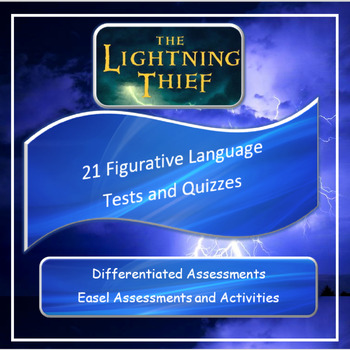The Lightning Thief Figurative Language for the Whole Novel
- Word Document File
- Easel Activity
- Easel Assessment
Description
Dear Educators,
This product identifies three hundred thirty-nine figures of speech in Rick Riordan’s novel, The Lightning Thief. These differentiated assessments were written for traditional and inclusion classrooms.
This Product Includes:
- 386 Pages
- Teacher’s notes
- Study guide
- Cut out study sheet/game
- One practice quiz with 26 questions
- 5 Practice work sheets 12 questions each
- 7 Tests with figurative language quoted from the novel
- 7 Modified tests with figurative language quoted from the novel
- 14 Quizzes with figurative language quoted from the novel
- 14 Modified quizzes with figurative language quoted from the novel
- 483 Questions based on quotes from the novel
- 574 Questions in all
- Detailed answer keys
- 18 Easel Activities
- 15 Easel Assessments
Teacher’s Notes:
- Definitions for: simile, metaphor, onomatopoeia, personification, hyperbole, idiom, flashback, foreshadowing, sarcasm, repetition, imagery, conflict, and alliteration
- Helpful examples for: simile, metaphor, onomatopoeia, personification, hyperbole, idiom, flashback, foreshadowing, sarcasm, repetition, imagery, conflict, and alliteration
Study Guide:
- Definitions for: simile, metaphor, onomatopoeia, personification, hyperbole, idiom, flashback, foreshadowing, sarcasm, repetition, imagery, conflict, and alliteration
- Helpful examples for: simile, metaphor, onomatopoeia, personification, hyperbole, idiom, flashback, foreshadowing, sarcasm, repetition, imagery, conflict, and alliteration
Cut Out Study Sheets:
- Sheet 1 of 2: simile, metaphor, onomatopoeia, personification, hyperbole, idiom, conflict.
- Definitions: simile, metaphor, onomatopoeia, personification, hyperbole, idiom, conflict.
- Sheet 2 of 2: flashback, foreshadowing, sarcasm repetition, imagery, and alliteration
- Definitions: flashback, foreshadowing, sarcasm repetition, imagery, and alliteration
- Instructions for study guide and game
Practice Quiz:
- Part I ~ 13 matching questions
- Part II ~ 13 multiple choice questions
- Modified quiz for Part I
Practice Work Sheets:
- 5 Work sheets
- Multiple choice
- 13 Questions each
- 5 Modified work sheets
Tests and Quizzes with Quotes from the Novel:
- Chapters 1 – 3 has 57 questions for part I; 11 for part II; and 11 for part III
- Chapters 4 – 6 has 53 questions for part I; 7 for part II; and 8 for part III
- Chapters 7 – 9 has 57 questions for part I; 14 for part II; and 15 for part III
- Chapters 10 – 12 has 37 questions for part I; 5 for part II; and 5 for part III
- Chapters 13 – 15 has 41 questions for part I; 11 for part II; and 11 for part III
- Chapters 16 – 18 has 32 questions for part I; 6 for part II; and 6 for part III
- Chapters 19 – 22 has 62 questions for part I; 17 for part II; and 17 for part III
- Part I - Multiple choice. Directions: The following quotes were taken from The Lightning Thief. Identify the correct figurative language in each quote. If it is a simile underline the things being compared.
- Part II - Multiple choice. Directions: Identify the correct literal meaning of the figures of speech in the following quotes from The Lightning Thief.
- Part III - Directions: 1. Identify the figure of speech for each quote from The Lightning Thief. 2. Explain the literal meaning of the figurative language. 3. Write in a complete sentence. Plus, an example with answer for each quiz.
- Page and paragraph number for each question
- Parts two and three are made up of quotes from part one. While this may seem like duplication the aim is to test students’ understanding of the literal meaning of the figurative language without giving away the answer.
- Modified quizzes are included
Detailed Answer Keys:
- Answer keys are copies of the quizzes with detailed answers
- Page and paragraph numbers for each question from the novel
- Notation of each chapter on answer key
Easel Assessments: Parts I and II
- Chapters 1 – 3; Parts I & II 68 questions
- Chapters 4 – 6; Parts I & II 60 questions
- Chapters 7 – 9; Part I; 57 questions
- Chapters 7 – 9; Part II; 14 questions
- Chapters 10 – 12; Parts I & II; 42 questions
- Chapters 13 – 15; Parts I & II; 52 questions
- Chapters 16 – 18; Parts I & II; 38 questions
- Chapters 19 – 22: Part I; 64 questions
- Chapters 19 – 22; Part II; 17 questions
- One practice quiz with 26 questions
- 5 Practice quizzes 13 questions each
- All multiple choice
Easel Activities:
- Self-checking practice quiz part one
- Self-checking modified practice quiz part one
- Self-checking practice quiz part two
- Self-checking modified practice quiz part two
- 7 quizzes for Part III with answer boxes
- 7 modified quizzes for Part III with answer boxes
- Ready to assign, just one click!
This entire product is available in Easel.
Since page numbers are included for each quote, you can use this product for classroom/homework assignments by asking students to find examples of figurative language on specific pages and/or in specific chapters.
I’m sure you and your students will be happy to use this material in your classroom. If you have any requests about my work, please drop me a note.






